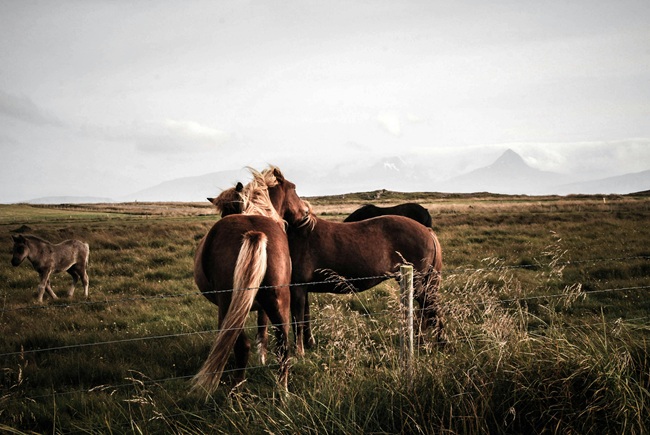
Horses relate through body language, and the tail is one of their most expressive “talking” parts. It is used to communicate information about their physical and emotional states both within the herd and between horse and rider. The consummate herd animal, the horse depends on his equine peers for his very survival. Over millions of years, horses have developed a complex system of tail signals that enable members of a herd to “discuss” matters that are essential to group maintenance.
Reproductive success, for example, is necessary to herd stability, and some tail signals are devoted exclusively to communications regarding procreation. In the presence of stallions, mares in heat will lift their tails up and to one side, sort of a “come hither” motion to indicate sexual receptiveness. If they’re already in foal, they will warn away would-be suitors with an aggressive side-to-side swish of the tail. The survival of the herd depends on the group’s ability to communicate and detect danger. A slightly raised tail, in combination with the “ready” stance, weight on all four feet, ear pricked forward, means “Alert! Stop what you’re doing and await further instructions!” Protective stallions, in displays to frighten off invaders, will lift their tails, prance, and defecate.
As members of a herd hammer out their hierarchy and preferred relationships, their tails speak of hostilities quashed, disciplinary measures taken, and friendships formed. Standing head-to-tail in groups of two, longtime pals contentedly swish flies from each other’s faces. Frisky foals engage each other in games and races with their tails held high, a sure sign of excitement and high spirits. But overly boisterous youngsters and bold upstarts often will be warned off by an elder’s hunched rump and twitching tail, indicating readiness to deliver a good, swift kick to the offender. The subordinate animal, duly chastened, clamps his tail between his hind legs, finally rendering to his superior.
Horses speak to their human companions in similar way. And an owner who “tunes in” soon learns to read and heed his equine charges’ body language. In general, the tail complements the position and attitude of the horse’s head and neck: When they’re up, it’s up, and vice versa. A horse who swishes his tail from side to side in an agitated manner is not pleased with what he’s being asked to do. The activity is causing him either psychological or physical discomfort, and the situation should be analyzed to discover the root of the problem. Another signal, a tightly clamped tail, can be read in either of two ways. Accompanied by bunched rump muscles, it’s a surefire sign that the horse is ready to explode. “Get ready for a buck or a kick.” But if the horse is standing still, looking miserable, and perhaps occasionally stamping his feet, it’s an indication of discomfort in the belly or hindquarters.
Provided by Creatures Corner reader Sarah King
Related Articles & Free Email Newsletter Sign Up
A Steady Hand Makes for a Happier Horse
Do Not Allow Your Horse to Invade Your Space
Why Horses can Sleep While Standing


Comment here